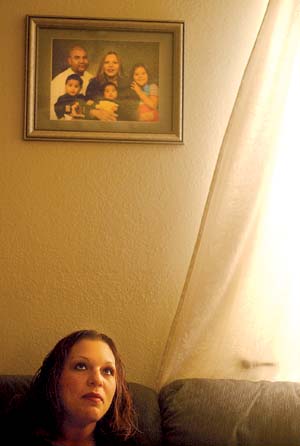Teresa Rubio remembers the day her daughter, Monique, saw Bambi
for the first time and the pain the two-year-old felt when the
young fawn was left alone after his mother died.
Hollister – Teresa Rubio remembers the day her daughter, Monique, saw Bambi for the first time and the pain the two-year-old felt when the young fawn was left alone after his mother died.
“She just kept asking, ‘Why did the mom have to die?,'” Rubio said. “She understood the idea of loss even then.”
Since then, Monique and Teresa’s two other children cope with the idea of losing their own mother on a daily basis. After giving birth to Monique, Rubio was diagnosed in 2000 with lymphoma – a type of cancer that attacks the immune system. In the four years since the frightening discovery, she has had two more children, Angel and Xavier, and in the process gone through years of chemotherapy and one failed bone marrow transplant using her own cells. She has since been hoping – waiting – for a donor that may never arrive. She wants to live, but not for herself. It’s the idea of leaving her children that keeps her searching.
“If I didn’t have my kids, I wouldn’t be trying to get cured,” Rubio said. “I mean, a bone marrow transplant is a hard thing. It’s really bad. You get it and then you’re just sick for so long. You can’t do anything.”
But she has been unsuccessful in finding a donor whose tissue type matches her own. Even a recent national search failed to find her a match.
“It’s really hard, because you’re pretty much looking for your twin out there,” said Rubio, whose two brothers were tested but failed to match. So, in hopes of finding a match, she and her family decided to search closer to home by organizing a bone marrow testing drive this weekend.
However, Rubio wants to make sure people help for the right reasons. Not just because she needs help, but because someone, somewhere, someday might need a donor to save their life, especially ethnic minorities.
About 70 percent of patients needing a bone marrow transplant are forced to find a donor outside of their family members, according to the National Marrow Donor Program (NMDP), but minorities are underrepresented in the NMDP registry of potential donors. Because successful marrow transplants rely on the matching of tissue types, and because tissue types are genetic, patients in need of them are more likely to find matching donors within their own race. According to Dr. David Miklos of the Stanford University Department of Medicine’s Bone Marrow Transplantation Division, this is a huge problem.
“They’re (the NMDP) making conscious efforts in funding drives for unique, underrepresented ethnic groups to try to improve the situation, but it’s going to take more people from those groups” to make a difference, Miklos said.
Dr. Keith Stockerl-Goldsteim of the Stanford Bone Marrow Transplant Center agrees.
“Things are definitely better than they used to be. If you look now as opposed to a few years ago, the chances of finding a match for any ethnicity have gone up. But it’s still harder to find matching donors for minorities than for Caucasians,” he said.
The lack of ethnic potential donors is not limited to Hispanics, like Rubio. There is a great need for donors of all ethnicities – including those mixed with Caucasian – but African-American tissues are particularly difficult to find a match. In fact, according to the NMPD, African-Americans only have about a 60 percent chance of finding an outside donor. Hispanics have about a 79 percent chance of finding an outside donor, while Caucasians have the highest chance of finding matches at 85 percent. So, even though Rubio has a better chance of finding a donor than patients of a few other ethnicities, she and other Hispanics with lymphoma and other cancers still need help.
There is a ray of hope for Rubio and others suffering similar diseases because an International Bone Marrow Registry tracks matching tissue types across the globe. If a match is found anywhere in the world, the registry will know about it and Rubio could find a potential donor, but only if people take the time to get tested.
“It’s not just ‘What if your brother or sister gets sick?’ or ‘What if your kid needs it (marrow) one day?’ You could be saving anyone’s life in the world someday,” Rubio said.
Encouraging local residents to get tested is the biggest reason Rubio says her family has worked to bring the marrow-testing drive to Hollister this weekend.
“People don’t have to drive all the way out to King City or Salinas and pay to be tested,” she said.
She wants to make it as easy as possible for Hollister residents to donate and maybe save lives. By donating at the drive on Sunday, volunteers can be tested in groups, for free. The entire process takes about half an hour.
The bone marrow testing drive will be held on Sunday, Oct. 17, from noon to 4pm at the O’Reilly Youth Center behind the Sacred Heart School at Fifth and College streets in Hollister. Potential donors can be of any ethnicity, and should be between 18 and 60 years of age, in good health, and no more than 20 percent over ideal weight.
Drives such as this one, said UCSF Medical Center’s Senior Public Information Representative Janet Basu, are exactly what the NMDP is trying to do more of. Although bone marrow used to be extracted from a donor’s pelvis, many illnesses, like Rubio’s, can be cured with a simple blood donation.
“It’s so important to have a marrow drive,” she said. “Bone marrow really does save lives, and it’s not as painful as it used to be.”
Jessica Quandt is a staff writer for the Free Lance. Reach her at 831-637-5566 ext. 330 or at jq*****@***********ws.com.










